Administrators visit Gough Island
Report and photos from Joint Tristan Administrators
Fiona Kilpatrick and Steve Townsend
Having been on Tristan for over 20 months without a break, we were both excited when the Fisheries team suggested we join them for a short trip to Gough for the transit voyage. This is the beginning of the season, when the MFV Edinburgh visits all the main islands in the archipelago, and the fisheries team assess the lobster - abundance, size and location, among other things. The assessment is carried out as near as possible in the same places at the same time each year, to build up a long-term picture of the stocks.
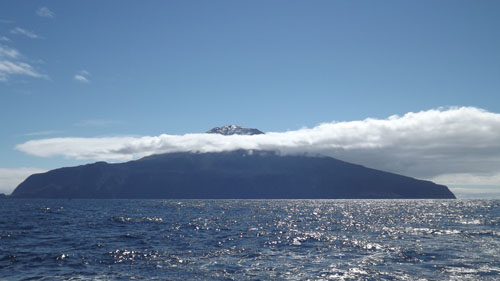
Classic view of Tristan da Cunha on 28th September from aboard MFV Edinburgh en route to Gough Island.
We set off at mid-day on 28th September 2021, heading out to the Edinburgh on the Fisheries RIB (the Jasus Tristanii) and were hoisted aboard in state. After enjoying the sight of snow on the Peak on Tristan, a steady voyage brought us to Gough a day later, and we fired off some of the lines and enjoyed the views of this (almost) lost world. An early start next morning as we clambered down into the factory facility on the Edinburgh, to watch the lobster come down the chute, and observe counting and measuring. Anything under 75cm, and berried females, are returned to the sea. We learned how to sex a crayfish, which will presumably come in handy one day! There was very little bycatch, which is good news as it keeps down the impact of the fishery on the surrounding environment.
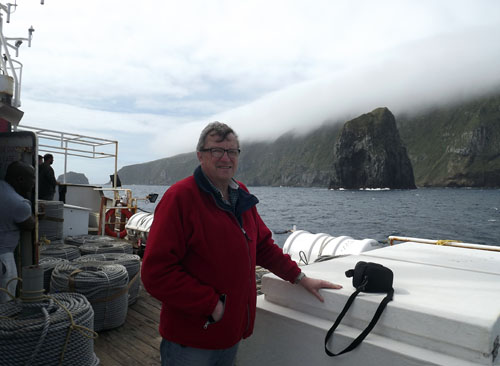
Steve Townsend looks overlooks the Gough coastline on arrival on 29th September.
There were some challenges at Gough, as the famed personnel carrier was not functioning. As we awaited news, we took the RIB out and sailed through calm waters up the eastern coast of the island. Plenty of penguins and seals to see, and then as we arrived at The Glen, we decided to pile into the dinghy and go ashore. This led to an interesting competition of who could do the least elegant transfer to the dinghy and get out again. It was a close-fought contest ending in a draw for everyone! But we landed safely and explored the remains of the old base, with rocks engraved by past expeditions and lots of baby fur seals. The tranquillity of this spot was hard to leave, but we set off again to circle Penguin Island, and buzz the Agulhas II which was anchored up nearby.
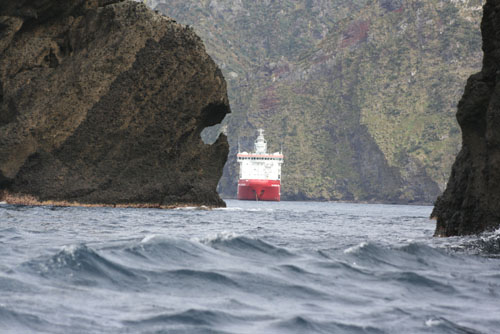
SA Agulhas II anchored near The Glen.
On our return to the Edinburgh, it transpired that the wonderful Ian Lavarello had sorted out our landing the next day at the Met Station, with a new and functioning carrier to take us up some 40 metres. It was a great deal less scary that we expected, and passing some of the sooty albatross nests on the way was a fantastic distraction.
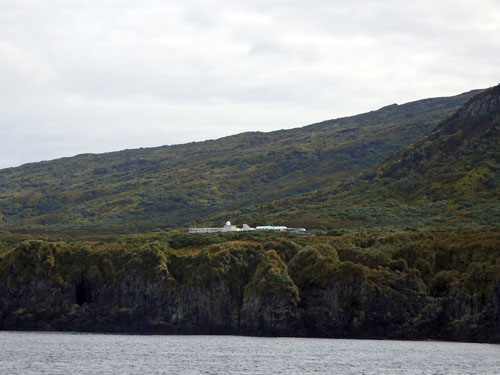
View of the South African Meteoroplogical Station on the plateau above Transvaal Bay.
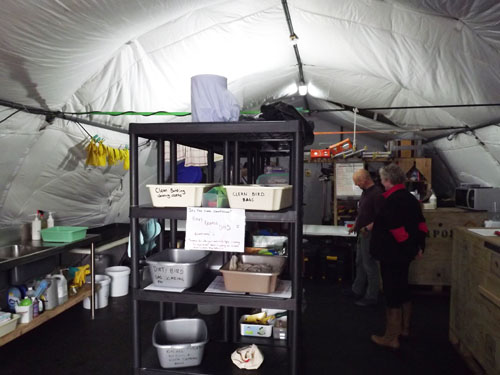
Fiona being shown equipment used to care for the Gough landbirds - buntings or finches and moorhens
during the Gough Restoration Programme to eliminate invasive house mice on the island.
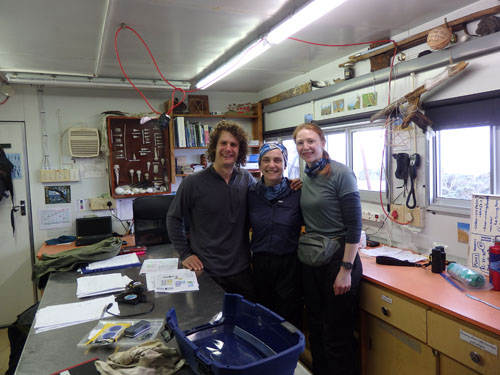
RSPB field workers Roelf Daling, Vonica Perold and Kim Stevens inside the Met Station research base.
The rest of the day was packed. Firstly, a visit to the tunnels where buntings and moorhens have been sheltered during the mouse bait drop, and are now starting to be released. Gough buntings are very endearing and curious birds, and it was quite hard to drag ourselves away. We had briefings with the South African weather service personnel about their work; RSPB (George and Antje) about the eradication project and the (hopefully bird-filled) future. We also had the opportunity to assess the current state of the station, where South African colleagues are working to stabilise key buildings, and have installed a rather snazzy emergency evacuation hut.
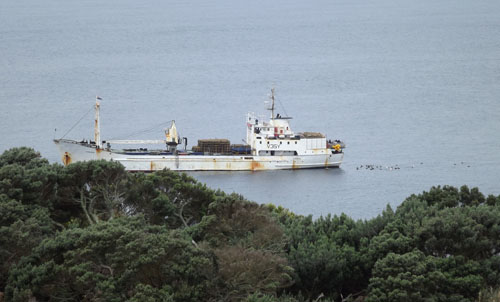
MFV Edinburgh viewed from the Met Station
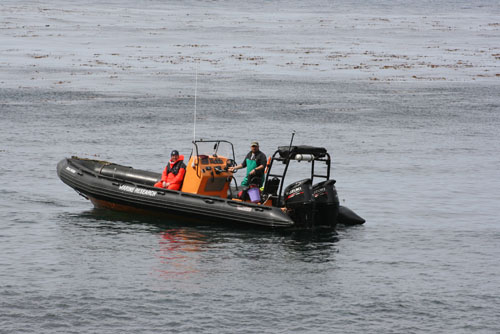
Head of Fisheries and Chief isander James Glass with fellow-islander Rodney Green
aboard the fisheries RIB Jasus Tristani during work to sample Tristan rock lobster on 30th September.
After an excellent lunch, we took a gentle walk punctuated by the alarmed rumblings of underground prions and shearwaters in their burrows, and the imperious gaze of yellow-nose albatrosses on their nests. The peeoos (sooty albatrosses) lived up to their onomatopoeic Tristan name as the flew over the cliffs - they are the most beautiful birds. Sadly, we did not have time to visit the Tristan Albatross nests, but we saw plenty of the majestic birds on our travels.
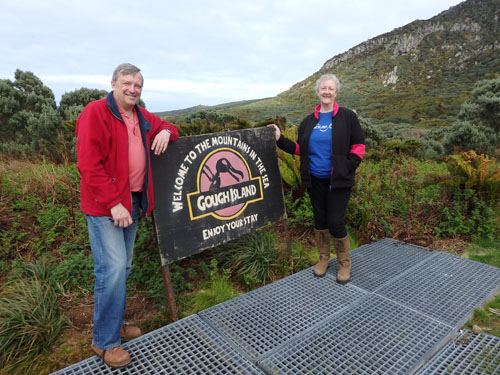
Steve and Fiona by the now-famous Gough Island welcome sign.
'Mountains in the Sea' was the title of Sir Martin Holdgate's book about the 1955/56 Gough Island Scientific Survey.
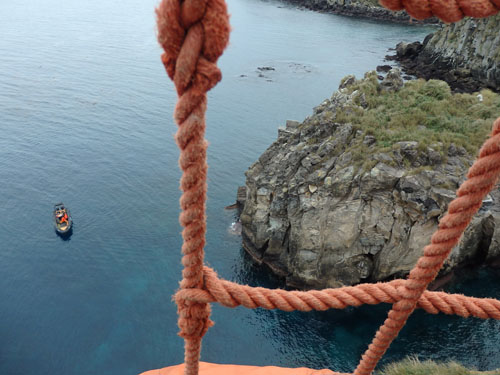
Photograph taken from 'aboard' the platform of the crane lift that transports people
from inshore vessels (the RIB Jasus Tristani awaits below) to and from ships.
In this case, the occasion was Fiona and Steve's departure from Gough on 1st October.
Not an experience for the faint-hearted!
Our journey back was a little rough, and we sheltered in the lee of Inaccessible. Not having had the chance to visit the northern islands together during our time here, we had the prospect of a visit to all of them, but the residual swell from the rough weather negated that. We returned to Tristan via Nightingale - no landings, but lovely views.
It's always a bit hit and miss as to whether Administrators can visit Gough, but mostly they have managed it - a highlight of any posting on Tristan, and a gentle reminder to the world that Gough, too, is part of the territory.
